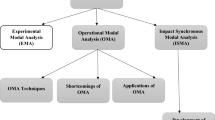Abstract
Cantilever steel beams of uniform strength are having various industrial applications. In particular when it is used as leaf spring it undergoes very large deflection in comparison to beam of uniform cross section. The damage occurs in these beams mainly due to fatigue loading. Early detection of damage in such type of beams is very essential to avoid a major failure or accident. In this paper, firstly formulation of an objective function for the genetic search optimization procedure along with the residual force method are presented for the identification of macroscopic structural damage in an uniform strength beam. Two cases have been investigated here. In the first case the width is varied keeping the strength of beam uniform throughout and in the second case both width and depth are varied to represent a special case of uniform strength beam. The developed model require experimentally determined data as input and detect the location and extent of the damage in the beam. Here, experimental data are simulated numerically by using finite element models of structures with inclusion of random noise on the vibration characteristics. It has been shown that the damage may be identified for the said problems with a good accuracy.
Similar content being viewed by others
References
Cawley P, Adams RD (1979) The location of defects in structures from measurement of natural frequencies. J Strain Anal 14(2):49–57
John EM, Michael IF, Cristinel M (1999) Method for determining model structure errors and for locating damage in vibrating systems. Meccanica 34(3):153–166
Abderrazek D, Nouredine O, Nacer H (2008) Detection of rolling bearing defects using discrete wavelet analysis. Meccanica 43(3):339–348
Gawronski W, Sawicki JT (2000) Structural damage detection using modal norms. J Sound Vib 229:194–198
Stubbs N, Osegueda R (1987) Global non-destructive damage evaluation of offshore platform using modal; analysis. In: Proceedings of the 6th international offshore mechanics and artic engineering symposium, vol 2, pp 517–224
Yang QW, Liu JK (2007) Structural damage identification based on residual force vector. J Sound Vib 305:298–307
Hajela P, Soeiro FJ (1990) Structural damage detection based on static and modal analysis. AIAA J 28(4):1110–1115
Awrejcewicz J, Krysko VA, Krysko AV (2004) Complex parametric vibrations of flexible rectangular plates. Meccanica 39(3):221–244
Chakraverty S, Jindal R, Agrawal VK (2007) Effect of non-homogeneity on natural frequencies of vibration of elliptical plates. Meccanica 42:585–599
Goldberg DE (1989) Genetic algorithms in search, optimization and machine learning. Addsion-Wesley Longman, Reading
Chakraverty S, Singh VP, Sharma RK (2006) Regression based weight generation algorithm in neural network for estimation of frequencies of vibrating plates. Comput Methods Appl Mech Eng 195:4194–4202
Tsou P, Shen MHH (1994) Structural damage detection and identification using neural networks. AIAA J 32:176–183
Barai SV, Pandey PC (1995) Vibration signature analysis using artificial neural networks. Trans ASCE J Comput Civil Eng 9:259–265
Mares C, Surace C (1996) An application of genetic algorithm to identify damage in elastic structures. J Sound Vib 195:195–215
Perera R, Torres R (2006) Structural damage detection via modal data with genetic algorithms. J Struct Eng 132(9):1941–1501
Marawala T, Chakraverty S (2006) Fault classification in structures with incomplete measured data using auto associative neural networks and genetic algorithm. Curr Sci 90(4):542–548
Rajasekaran S, Pai GAV (2003) Neural networks, fuzzy logic, and genetic algorithms, synthesis and applications. Prentice-Hall of India Pvt, New Delhi
Rao SR, Ganesan N (1997) Dynamic response of non-uniform composite beams. J Sound Vib 200(5):563–577
Subramanian G, Raman A (1996) Isospectral systems for tapered beams. J Sound Vib 198(3):257–266
Al-Kaabi SA, Aksu G (1990) Free vibration analysis of mindlin plates with parabolically varying thickness. Comput Struct 34(3):395–399
Yeh K, Tang X (1988) Uniform strength design of beams with non-zero minimum flexural rigidity under multiple loadings. Appl Math Mech 9(2):113–122
Rahaman, A, Kowser, A, Hossain SMM (2006) Large deflection of the cantilever steel beams of uniform strength-experiment and non-linear analysis. Int J Theor Appl Mech 1(1):21–36
Rao MA, Srinivas J, Murthy BSN (2004) Damage detection in vibrating bodies using genetic algorithms. Comput Struct 82:963–968
Ratnam Ch, Rao DVP (2004) Identification of damage in structures using genetic algorithm. IE (I) J MC 154–160
Panigrahi SK, Chakraverty S, Mishra BK (2007) Identification of damage in structural members using genetic algorithm. National conference on emerging technology and developments in civil engineering’(ETDCE-07), Govt Eng College, Amaravati, 22–23 March, 2007, pp V71–78
Michalewicz Z (1994) Genetic algorithms + data structure = evolution programs, 2nd edn. Spring, Berlin
Author information
Authors and Affiliations
Corresponding author
Additional information
S. Chakraverty is on Lien from Central Building Research Institute, Roorkee, India.
Rights and permissions
About this article
Cite this article
Panigrahi, S.K., Chakraverty, S. & Mishra, B.K. Vibration based damage detection in a uniform strength beam using genetic algorithm. Meccanica 44, 697–710 (2009). https://doi.org/10.1007/s11012-009-9207-1
Received:
Accepted:
Published:
Issue Date:
DOI: https://doi.org/10.1007/s11012-009-9207-1




